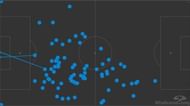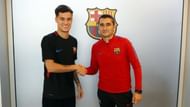
The winter transfer window is open and roaring with numerous teams going all out to land the players on their wish-list. Liverpool made a huge statement by breaking the record transfer fee for a defender by signing Virgil Van Dijk for 75 million.
That has been followed by another record being broken with Coutinho becoming only the 2nd most expensive player in the world after Neymar (barring Kylian Mbappe). However, a transfer of this magnitude generally happens in the summer window and hence, there was always an element of doubt regarding its possibility in January.
But all's well that ends well for Barcelona as they have finally got their man and they have also made him the most expensive signing since the club’s inception.
A major advantage that Coutinho brings is his ability to play in different roles or positions than just being a central-midfielder. The Brazilian can play on either side of the flank with the left being the more natural side and thus, it gives Barcelona coach Ernesto Valverde multiple ways to fit him in the eleven.
Having played under Jurgen Klopp, Coutinho is also accustomed to counter-pressing. In simpler words, it is the high pressing applied immediately after losing the ball to win back possession and try to attack higher up the pitch.
This has been part of the Barcelona DNA for over a long period of time now and new recruits like Andre Gomes, Aleix Vidal and Arda Turan have struggled to get used to the counter-pressing given the contrasting styles of football they had played in their previous clubs while it might not be an issue with Coutinho.
Let us analyse the role he is likely to play for the Blaugrana and what he would bring to the team:
The main purpose behind the signing of the Brazilian is to replace the legendary Andres Iniesta in the long-run while to add squad depth for the time being. Thus the central midfield is where Coutinho will majorly feature and there aren’t many in world football right now who are closer to the ‘Iniesta mould’ than the former Liverpool man.
Moving the team up-field
When deployed in the middle-muddle, he is extremely adept at moving the team up the field during build-up or positive transition. This is the most sought-after skill in a central-midfielder playing for a team like Barcelona as they prefer to play out from the back than launching long balls ahead.
Coutinho often drops deep into midfield facing his own goal to open himself as a passing option during build-up play. The skills and decision-making of a player in these situations serve as a litmus test to find out if he has enough quality to thrive in a team like Barcelona.
In the case of Coutinho, he has the ability to beat his man with a simple shoulder drop and immediately drive forward into the final third to put his team in the driving seat. There is no doubt that it would help Barcelona overcome the high-press not only during build-up but also during the positive transition and to initiate counter-attacks.
Another important point to be noted is that barring Iniesta, none of the other Barcelona midfielders are capable of moving the team up-field. Thus, it would be absolute necessary for the Catalans to have someone other than the ageing World-Cup winner to take up such challenges as it might not be too long before physical constraints take a toll on his game.

The image above shows Coutinho's touches against Tottenham from the humiliating 4-1 defeat at Wembley. It was probably one of the toughest games for Liverpool this season as Spurs suffocated them for space and it forced Coutinho to drop deeper into midfield to bring the ball quickly into the final third from their own half.
After Klopp decided to allow the Brazilian to do so, it benefitted both him and Liverpool as there were signs of improvement while going forward.
Goal-scorer
Despite the resemblance with Iniesta, Coutinho can also bring a different dimension to Barcelona’s midfield trio. This is with regard to the Brazilian’s eye-for-goal as more often than not, he is on the scoresheet owing to his rocket-like shots.
Coutinho has the ability to test the goal-keeper from any distance as when he connects the ball with his laces, the sheer power, precision and accuracy of the shot is second to none in the world. Hence, the opposition are often left in a dilemma of closing down or backing off.
If they get too close to him, he can dribble past them but if they back off to give him enough time and space, it is going to lead to an opportunity for him to shoot. He offers the much-needed variety for the Barca midfield as majority of the oppositions try to defend deep in blocks.
Thus when the Catalans find it difficult to pass their way through the opposition, then they can always make use of the space by allowing Coutinho to test the goalkeeper from long range.
Another feature of his gameplay as a midfielder is his tendency to run into the box in order to get into shooting positions. For instance, if one of the Barcelona full-backs are in possession and just about to deliver a threatening cross, Coutinho gambles and gets into the box as an additional scoring option.
The former Liverpool man likes to attack the ball and thus by giving those odd runs, he can make marking inside the penalty area a real headache for the opposition, especially with the likes of Suarez, Messi & Paulinho hovering around the same area.
Vertical play
Apart from having an eye for goal, Coutinho differs from Iniesta in another aspect: Verticality. Be it passing or driving the ball, the £142m man is direct with his approach and prefers to increase than reduce the tempo.
However, Iniesta used to be in charge of the same back in the day when he was alongside Xavi, whose role was to dictate play. Over the years, Iniesta has evolved to be a different player in comparison to what he was.
The Spaniard’s tendency to take on players, deliver the final ball or have a go at goal has gradually reduced while on the other hand, Coutinho’s strengths precisely are the three factors mentioned above.
It will be all the more important to Barcelona as this vertical play adds some much-needed unpredictability to their gameplay in the final third and oppositions may not be able to simply sit back with the expectation of the ball being moved only from side to side.
Here are some interesting numbers comparing Barca's latest recruit to other playmakers in the Premier League:
Philippe Coutinho: Passes per game 48, Forward Passes 69%
Cesc Fabregas: Passes per game 66. Forward Passes 67%
Paul Pogba: Passes per game 68, Forward Passes 66%
Kevin De Bruyne: Passes per game 72, Forward Passes 60%
Mesut Ozil: Passes per game 68, Forward Passes 60%
Christian Erkisen: Passes per game 57, Forward Passes 56%
David Silva: Passes per game 83, Forward Passes 54%
Versatility: Ability to play on the wings
Coutinho is a lot more involved in goals and assists from the left wing as he is closer to goal and also has lesser responsibilities in build-up play and defence. Although he starts out-wide on the left, he often drifts towards the centre allowing the left-back to make overlapping runs down the left flank.
This could help the likes of the in-form Jordi Alba to have a good rapport on the pitch with the Brazilian. Coutinho is undoubtedly one of the best dribblers in the world and thus when he receives the ball out wide, he gets 1v1 scenarios with the opposition right-back who could be terrorized by his trickery.
He generally floats around the edge of the penalty area and then makes his decision whether to go for a curler of a shot or a diagonal cross to the far post or to feed an on-coming attacker or a simple cross-field pass to change the focal point of attack to the other flank.
A majority of Coutinho’s goals and assists for Liverpool have come when he drives in-field with the ball stuck to his feet and it is for this reason that he doesn’t stay close to the touchline unlike traditional wingers.

As you can see in the image above, Coutinho's in-field drive with the ball followed by a diagonal cross to the far post has proven to be effective with the attackers making threatening runs.
With the likes of Messi, Suarez & Dembele looking to get in behind the opposition's back four, it only means that a meatier role is in store for Coutinho with the Catalan giants.
To make the best use of his skill set, he tries to be on the ball as much as possible and actively involves himself in the final third. So irrespective of the position he starts in, there is a tendency to move more towards the central areas.
This means that Valverde needs to ponder upon how he would fit Coutinho into the system alongside Iniesta and Messi in the final third as it shouldn't be a case of having one too many players who are similar to each other, together at the same time.
Coutinho's numbers as central-midfielder:
Played 10, Goals 5, Assists 3, Passes per game 55, Dribbles per game 3, Key passes per game 3
Coutinho's numbers as left-winger:
Played - 7, Goals - 7, Assists - 5, Passes per game - 51, Dribbles per game - 4, Key passes per game - 3
Free kicks
Although it is Lionel Messi who is in complete control of this department for the Blaugrana, Coutinho has proven on several occasions that he can harm the opposition from dead-ball situations.
The left side of the goal with a distance of 20-25 yards out is his ideal territory as he can elevate the ball over the wall and curl it into the far post or if the distance is too close he can even go for a zipping grounded shot below the wall. He has scored 5 goals from direct free-kicks in the Premier League since his arrival at the Anfield.
Conclusion

After the success of the 4-4-2 diamond, Valverde now has a plan-B apart from the traditional 4-3-3 of Barcelona. As far as the 4-4-2 is concerned, he could be used as a direct replacement for Iniesta or as a number 10 behind Messi & Suarez.
In the case of 4-3-3, the Brazilian could again be a direct replacement for Iniesta or as the left winger (where Neymar used to play). However, having both Coutinho & Iniesta as part of the midfield trio could be a risk as it may lead to a lack of defensive diligence. Thus the inclusion of Rakitic will be necessary to ensure there is a combination of silk and steel in the middle.
Valverde has helped players like Paulinho, Nelson Semedo settle seamlessly into the club and both of these new signings have delivered what was expected of them. It will be interesting to see the process of Coutinho’s inclusion into the team with a plethora of talent available at his disposal.
When the Barcelona boss was questioned about Coutinho’s role in the squad, he made it clear he didn’t want to reveal his plans as he cheekily said that the Brazilian is surely not going to be the goal-keeper.
But Valverde also confirmed that he is aware of the Coutinho’s ability to play in multiple positions, leaving what is in store for the remainder of the season to our imagination.
